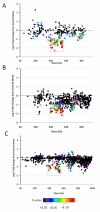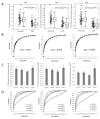Reduced levels of hydroxylated, polyunsaturated ultra long-chain fatty acids in the serum of colorectal cancer patients: implications for early screening and detection
- PMID: 20156336
- PMCID: PMC2833138
- DOI: 10.1186/1741-7015-8-13
Reduced levels of hydroxylated, polyunsaturated ultra long-chain fatty acids in the serum of colorectal cancer patients: implications for early screening and detection
Abstract
Background: There are currently no accurate serum markers for detecting early risk of colorectal cancer (CRC). We therefore developed a non-targeted metabolomics technology to analyse the serum of pre-treatment CRC patients in order to discover putative metabolic markers associated with CRC. Using tandem-mass spectrometry (MS/MS) high throughput MS technology we evaluated the utility of selected markers and this technology for discriminating between CRC and healthy subjects.
Methods: Biomarker discovery was performed using Fourier transform ion cyclotron resonance mass spectrometry (FTICR-MS). Comprehensive metabolic profiles of CRC patients and controls from three independent populations from different continents (USA and Japan; total n = 222) were obtained and the best inter-study biomarkers determined. The structural characterization of these and related markers was performed using liquid chromatography (LC) MS/MS and nuclear magnetic resonance technologies. Clinical utility evaluations were performed using a targeted high-throughput triple-quadrupole multiple reaction monitoring (TQ-MRM) method for three biomarkers in two further independent populations from the USA and Japan (total n = 220).
Results: Comprehensive metabolomic analyses revealed significantly reduced levels of 28-36 carbon-containing hydroxylated polyunsaturated ultra long-chain fatty-acids in all three independent cohorts of CRC patient samples relative to controls. Structure elucidation studies on the C28 molecules revealed two families harbouring specifically two or three hydroxyl substitutions and varying degrees of unsaturation. The TQ-MRM method successfully validated the FTICR-MS results in two further independent studies. In total, biomarkers in five independent populations across two continental regions were evaluated (three populations by FTICR-MS and two by TQ-MRM). The resultant receiver-operator characteristic curve AUCs ranged from 0.85 to 0.98 (average = 0.91 +/- 0.04).
Conclusions: A novel comprehensive metabolomics technology was used to identify a systemic metabolic dysregulation comprising previously unknown hydroxylated polyunsaturated ultra-long chain fatty acid metabolites in CRC patients. These metabolites are easily measurable in serum and a decrease in their concentration appears to be highly sensitive and specific for the presence of CRC, regardless of ethnic or geographic background. The measurement of these metabolites may represent an additional tool for the early detection and screening of CRC.
Figures






Similar articles
-
Metabolic system alterations in pancreatic cancer patient serum: potential for early detection.BMC Cancer. 2013 Sep 12;13:416. doi: 10.1186/1471-2407-13-416. BMC Cancer. 2013. PMID: 24024929 Free PMC article.
-
Reduction of novel circulating long-chain fatty acids in colorectal cancer patients is independent of tumor burden and correlates with age.BMC Gastroenterol. 2010 Nov 29;10:140. doi: 10.1186/1471-230X-10-140. BMC Gastroenterol. 2010. PMID: 21114854 Free PMC article.
-
[Metabolome Analysis of Human Serum: Implications for Early Detection of Colorectal Cancer].Rinsho Byori. 2015 Mar;63(3):328-35. Rinsho Byori. 2015. PMID: 26524856 Review. Japanese.
-
Specificity of metabolic colorectal cancer biomarkers in serum through effect size.Metabolomics. 2020 Aug 13;16(8):88. doi: 10.1007/s11306-020-01707-w. Metabolomics. 2020. PMID: 32789702
-
Screening of synthetic PDE-5 inhibitors and their analogues as adulterants: analytical techniques and challenges.J Pharm Biomed Anal. 2014 Jan;87:176-90. doi: 10.1016/j.jpba.2013.04.037. Epub 2013 May 6. J Pharm Biomed Anal. 2014. PMID: 23721687 Review.
Cited by
-
Low-serum GTA-446 anti-inflammatory fatty acid levels as a new risk factor for colon cancer.Int J Cancer. 2013 Jan 15;132(2):355-62. doi: 10.1002/ijc.27673. Epub 2012 Jun 26. Int J Cancer. 2013. PMID: 22696299 Free PMC article.
-
Distinct Urinary Metabolic Biomarkers of Human Colorectal Cancer.Dis Markers. 2022 Apr 26;2022:1758113. doi: 10.1155/2022/1758113. eCollection 2022. Dis Markers. 2022. Retraction in: Dis Markers. 2023 Jul 12;2023:9873530. doi: 10.1155/2023/9873530. PMID: 35521635 Free PMC article. Retracted.
-
Metabolic models predict bacterial passengers in colorectal cancer.Cancer Metab. 2020 Feb 10;8:3. doi: 10.1186/s40170-020-0208-9. eCollection 2020. Cancer Metab. 2020. PMID: 32055399 Free PMC article.
-
Metabolomics for biomarker discovery in gastroenterological cancer.Metabolites. 2014 Jul 7;4(3):547-71. doi: 10.3390/metabo4030547. Metabolites. 2014. PMID: 25003943 Free PMC article.
-
Untargeted lipidomic features associated with colorectal cancer in a prospective cohort.BMC Cancer. 2018 Oct 19;18(1):996. doi: 10.1186/s12885-018-4894-4. BMC Cancer. 2018. PMID: 30340609 Free PMC article.
References
-
- Solmi R, Ugolini G, Rosati G, Zanotti S, Lauriola M, Montroni I, del Governatore M, Caira A, Taffurelli M, Santini D, Coppola D, Guidotti L, Carinci P, Strippoli P. Microarray-based identification and RT-PCR test screening for epithelial-specific mRNAs in peripheral blood of patients with colon cancer. BMC Cancer. 2006;6:250. doi: 10.1186/1471-2407-6-250. - DOI - PMC - PubMed
MeSH terms
Substances
LinkOut - more resources
Full Text Sources
Other Literature Sources
Medical

